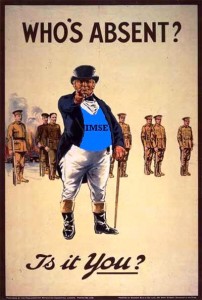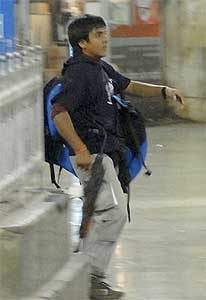 I recently returned from leave and
I recently returned from leave and some thistle-pulling and sagebrush clearing a family reunion and realized that the month of June has already ended. It’s surprising how fast the summer has arrived and equally surprising that in a week or so, CIMSEC and the NextWar Blog will have been active for three months. With the selection of a leadership team and our continued growth, I’m writing all of you in my new capacity as President to talk about where we have been and where we may dare go.
First, I have a running tab of gratitude to settle. To the established centers of thought who have encouraged us to strike out and begin writing, especially the teams at Information Dissemination and the US Naval Institute, thank you. Thanks specifically to LT Rob McFall, LCDR BJ Armstrong, Galrahn, Sam LaGrone, CDR Salamander, Peter Munson and CDR Chris Rawley for your advice, hyperlinks and shameless plugs. Thank you to our members, readers, authors, and all of the other interested parties who have lent their time and their minds to growing a new organization. There have been too many acts, both large and small, to name here. I hope that everyone who has posted on NextWar or on our facebook page realizes the significance they are having while at the tiller. Thank you for keeping the ship steady. Most of all, however, thanks is due to our Founding Director and current Vice President, Scott Cheney-Peters (anyone wish to second my motion to name him “Fearless Leader”?), whose vision and leadership have created an important new space in the discourse on securing the seas.
We have a lot to be proud of in the nearly three months we have been active. Under Scott’s leadership, CIMSEC has expanded from a ragtag band of junior officers into an organization with many dozens of members ranging from E-5 to O-8 in the U.S. military and countless other affiliations in government, industry, and think-tanks. We are most proud of the international facet of our identity; the lack of international dialogue on maritime security is a gap we sought to fill early-on as we contemplated our role in the defense blog ecosystem. We have members from countries all over the world, including Poland, Japan, the Philippines, Uruguay, the United Kingdom and Canada. Many of these international members are or will be active authors. We can learn much from each other. We’ve also sought to prove that a web platform can help give voice to less well-known authors. NextWar blog posts have been cited by many prominent defense blogs and websites as well as the Navy’s CHINFO Clips – so we have reason to keep our shoulder to the wheel. Our writing has also attracted partnerships with prestigious and diverse organizations such as the Atlantic Council of Canada, the Naval Institute, and TheRiskyShift.com – and we look forward to additional partnerships in the future. Finally, one friend of ours said in an email that CIMSEC is the realization of a maritime variant of Small Wars Journal. This humbling compliment is, to me, more of an admonition to continue what we’ve started and a worthy aspiration which I hope we can, in time, fulfill.
As with any new organization, the most exciting opportunities lie ahead. We need your help in the following areas to further grow and mature:
- Branding. Successful websites have a strong visual brand, and we aspire to present an appearance commensurate with our writing. I’m pleased to announce the “CIMSEC Logo Contest.” Anyone interested in fashioning CIMSEC’s new logo can submit art to me by 15 July. Images should be high resolution and fit in a rectangular shape (a ratio of 1:2.5 height/width). We are also looking for a “Favicon” which will appear in the URL line in most internet browsers, which should fit in a square (1:1 ratio). I will treat the winner of each category to liquid refreshment at our next meet-up. Thanks to Armando Heredia for stepping up to manage our online presence – you can contact him if you have more technical questions.
- Membership. Though we have grown significantly in membership and readership, increasing both will remain a priority. Each of you has a role to play in growing our base. Email links, tweet, “like” us on Facebook and use good ‘ol fashioned word of mouth to introduce us to new people. Again, we are proud of our International character, and are specifically seeking international members, readers, and contributors. LCDR A.J. Kruppa is directing our membership efforts – please contact him for more information.
- Publications. Our strategy for publication is simple: we will continue to publish the best possible writing on international maritime security. If we quietly pursue excellence, people will cross-post, read, link, like and discuss our products. Contact our Director of Operations and Editor of the NextWar Blog, LTJG Matt Hipple, if you are interested in posting. We are also excited about the NextWar Journal, a longform e-publication that will feature in-depth coverage of international maritime security issues. We are still seeking contributions for our first edition. Contact me if you’re interested in contributing to the journal.
- Organization. A personal priority for me will be to legitimize CIMSEC as a legal entity. We seek to incorporate as a non-profit organization in the United States and will pursue appropriate copyright and trademark protections for our work. Though the digital domain is still a wild frontier when it comes to intellectual property, pursuing these goals will allow CIMSEC to become as respected and as durable as our desires and ability allow.
- Social Media. We’re in the midst of a rapid expansion beyond our website to other forms of social media. More will follow from our Director of Social Media, Ben Purser, on this subject.
I’m honored to be a part of this organization and excited to see what the next three months bring. Don’t be afraid to get involved – this is your discussion!
LT Kurt Albaugh, USN is President of the Center for International Maritime Security, a Surface Warfare Officer and Instructor in the U.S. Naval Academy’s English Department. The opinions and views expressed in this post are his alone and are presented in his personal capacity. They do not necessarily represent the views of U.S. Department of Defense or the U.S. Navy.


